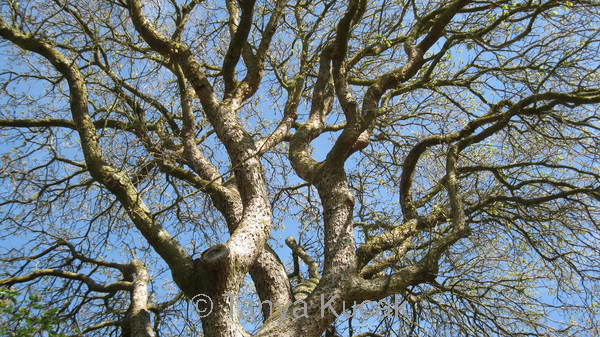
When she moved into her Los Altos house 46 years ago, Ruth Troetschler recognized the value of having a heritage oak tree in her backyard. Within a week, she'd pulled out the rhododendrons around its base. Ever since, she has nurtured the 200-300 year old valley oak by not disturbing the soil or watering within the tree's drip line. It has not been pruned except to remove branches encroaching on the roof.
If you visit this garden, you will see a California buckeye tree and a hollyleaf cherry growing under the heritage oak. These plants arrived as volunteers, and Troetschler wisely let them stay. The fallen oak leaves are also left in place to feed the soil life and support the insects and, in turn, the birds that are such a vital part of this garden.
For people, Troetschler planted dwarf fruit trees and vegetables. Little by little, in spots that were not suitable for fruit trees, she picked things that seemed to be right to attract birds and insects. Stunning blue flowers of a magnificent 45-year-old Julia Phelps ceanothus draw many pollinators and other beneficial insects in the spring. Though ceanothus are often considered short-lived in gardens, if you avoid watering once established, they can flourish for decades.
A blue oak that towers over the front yard planted itself 30 years ago and has grown over the ceanothus. Troetschler regularly has this oak tree trimmed to open up the dense canopy so other plants can grow under it.
As an entomologist, Troetschler pays attention to insects all the time. Her favorite plants are native buckwheats, which bloom in every season to provide nectar for beneficial insects. There's always a buckwheat coming along, she said. The easiest plant is hummingbird fuchsia, which blooms from midsummer until the first frost and attracts hummingbirds as well as beneficials.
She has planted more colorful, long-blooming natives as she's figured out a spot where they'll thrive. Troetschler loves the blue-purple color of Margarita BOP foothill penstemon, but it took three tries to find a place in her garden where it would grow. Woolly blue curls, known for its beauty and difficulty, thrived when she found the perfect spot with good drainage on the edge of a mound. In part shade, keckiella displays red-orange flowers for months.
Most surprising was a golden currant she mail-ordered from southern California, sight unseen, that succeeded the first time. Its lovely yellow flowers frame the gate to the backyard.
Well-behaved plants with a shorter bloom time, such as pink-flowering currant and douglas iris, are beautiful but offer only a flash of color. Troetschler likes long-blooming sages, but they grow too large for her 7000 sq. ft. lot.
The most memorable plant that didn't work out was fuchsia-flowered gooseberry, whose gorgeous red flowers were not enough to compensate for its rampant thorny stems. It's a useful barrier plant in the right location, though.
You can see the results of gardening to benefit people, birds, and insects for nearly a half century on Saturday, April 21, when the Troetschler garden welcomes visitors during the Going Native Garden Tour. The tour is free, but preregistration is required at http://gngt.org.

Blue oak was just beginning to leaf out in late March.
© 2012 Tanya Kucak